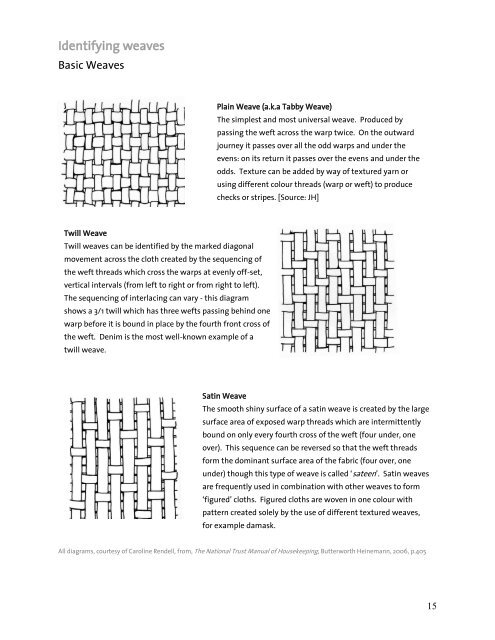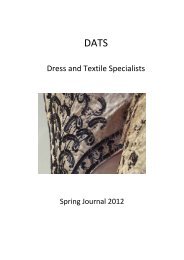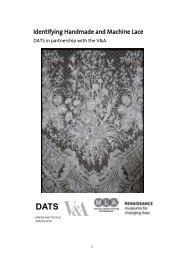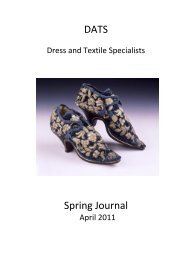Identifying Textile Types and Weaves 1750-1950 - Dress and Textile ...
Identifying Textile Types and Weaves 1750-1950 - Dress and Textile ...
Identifying Textile Types and Weaves 1750-1950 - Dress and Textile ...
Create successful ePaper yourself
Turn your PDF publications into a flip-book with our unique Google optimized e-Paper software.
<strong>Identifying</strong> weaves<br />
Basic <strong>Weaves</strong><br />
Twill Weave<br />
Twill weaves can be identified by the marked diagonal<br />
movement across the cloth created by the sequencing of<br />
the weft threads which cross the warps at evenly off-set,<br />
vertical intervals (from left to right or from right to left).<br />
The sequencing of interlacing can vary - this diagram<br />
Plain Weave (a.k.a Tabby Weave)<br />
The simplest <strong>and</strong> most universal weave. Produced by<br />
passing the weft across the warp twice. On the outward<br />
journey it passes over all the odd warps <strong>and</strong> under the<br />
evens: on its return it passes over the evens <strong>and</strong> under the<br />
odds. Texture can be added by way of textured yarn or<br />
using different colour threads (warp or weft) to produce<br />
checks or stripes. [Source: JH]<br />
shows a 3/1 twill which has three wefts passing behind one<br />
warp before it is bound in place by the fourth front cross of<br />
the weft. Denim is the most well-known example of a<br />
twill weave.<br />
Satin Weave<br />
The smooth shiny surface of a satin weave is created by the large<br />
surface area of exposed warp threads which are intermittently<br />
bound on only every fourth cross of the weft (four under, one<br />
over). This sequence can be reversed so that the weft threads<br />
form the dominant surface area of the fabric (four over, one<br />
under) though this type of weave is called „sateen‟. Satin weaves<br />
are frequently used in combination with other weaves to form<br />
„figured‟ cloths. Figured cloths are woven in one colour with<br />
pattern created solely by the use of different textured weaves,<br />
for example damask.<br />
All diagrams, courtesy of Caroline Rendell, from, The National Trust Manual of Housekeeping, Butterworth Heinemann, 2006, p.405<br />
15





